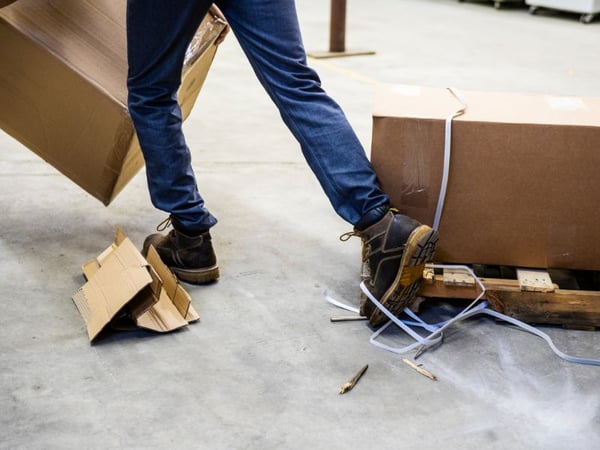In 2024, U.S. warehouses logged an injury rate of 4.8 cases per 100 FTEs, outpacing other sectors. Behind the pallets and powered trucks, associates face crushing musculoskeletal strain, forklift impacts, slips, and even burnout. Left unchecked, these hazards drain productivity and invite costly OSHA citations.
This article unpacks the 10 most common physical and psychological injuries, then hands you OSHA-compliant checklists, regional code tips, and proven Damotech solutions to keep every worker—and your bottom line—safe.
1. Musculoskeletal Disorders (MSDs)
Repetitive lifting, bending, and twisting overload muscles, tendons, and nerves, leading to chronic back pain, tendonitis, and carpal tunnel syndrome.
Real-world scenario – A Chicago e-grocery DC doubled its pick rate during Peak; 12 pickers reported shoulder strains, and two required modified duty.
Cost of inaction – Average MSD claim = $33,000 + 28 lost workdays (CBIA, 2015).
Prevention Checklist
- ✅ Introduce vacuum-assist or lift tables for loads > 50 lb.
- ✅ Rotate pickers every 2 hr and schedule hourly micro-stretch breaks.
- ✅ Floor-mark “no-lift” zones.

2. Forklift & Powered-Truck Accidents
Forklifts caused 67 deaths in 2023, and OSHA estimates between 35,000 and 62,000 injuries occur annually involving forklifts.
Real-world scenario – A Phoenix distributor’s stand-up reach truck tipped after turning on a wet polished-concrete floor.
Cost of inaction – Tip-over fatality settlement: $1.2 million + $48,000 penalty.
Prevention Checklist
- ✅ Cap aisle speeds at 5 mph.
- ✅ Install DAMO AISLE GUARD at the end of aisles to absorb impacts.
- ✅ Enforce annual operator recertification & seat-belt audits (OSHA 1910.178).
3. Struck-By / Caught-In-Between Incidents
Employees can be pinned between pallets, vehicles, or unracked loads.
Real-world scenario – A Dallas night-shift worker was crushed between back-to-back pallets when a clamp-truck driver reversed blindly.
Cost of inaction – Medical + comp = $92,000; 180 production hours lost.
Prevention Checklist
- ✅ One-way lanes; LED “blue-spot” pedestrian alerts.
- ✅ Spotters during blind reverse moves.
- ✅ Rack backing or netting for elevated pallet loads.
4. Slips, Trips & Falls
Slips, trips, and falls are often caused by factors such as poor lighting, cluttered walkways, and stepladders. However, uneven or wet surfaces are the primary cause, contributing to 55% of these incidents.
Real-world scenario – An Ontario DC logged 14 slip claims during the thaw season as snow-melt pooled at the inbound portal.
Cost of inaction – Average slip claim = $48,000; OSHA fines up to $16,550 per violation.
Prevention Checklist
- ✅ Enforce 5S housekeeping; daily floor walks.
- ✅ Specify ESR-rated slip shoes ≥ 0.40 COF.
- ✅ Repair floor defects > 6 mm within 24 h.

5. Cuts & Lacerations
Lacerations are common in warehouse and industrial settings, with sharp tools and splintered pallets being the primary causes of workplace injuries.
Real-world scenario – An Ohio carton line swapped to stainless blades; lacerations rose until auto-retract knives were mandated.
Cost of inaction – Avg laceration claim = $6,000 + 5-6 lost days.
Prevention Checklist
- ✅ Issue ANSI A4 cut-resistant gloves.
- ✅ Replace damaged pallets immediately.
- ✅ Train on auto-retract utility knives; supply safety knives.
- Two out of every five workplace hand injuries are lacerations.
- More than 1 million hand injuries occur annually in the U.S.; 63% involve knives.
- Lacerations account for 26.74% of machinery injuries and 55.86% of hand-tool injuries.
- According to OSHA’s $afety Pays calculator, a single laceration can cost companies over $45,000 in direct and indirect expenses.

6. Hazardous Materials & Respiratory Illness
Dust, diesel exhaust, or aerosols can trigger asthma and bronchitis.
Real-world scenario – A SoCal cold store switched to diesel chillers; particulate levels exceeded AQMD limits.
Cost of inaction – EPA fines can exceed $250,000. EPA enforcement actions have resulted in much larger fines, for example, settlements of $1,550,000 and $4.2 million.
Prevention Checklist
- ✅ Ventilate battery rooms to a minimum of 1 CFM per square foot; maintain 12-15 air changes per hour.
- ✅ Migrate to an electric fleet or fit scrubbers.
- ✅ Implement OSHA-compliant respiratory protection program, including medical evaluations, fit testing, and NIOSH-certified respirators when exposure limits are exceeded.
7. Overexertion & Fatigue
12-hour shifts erode concentration, with incidents spiking after hour 9.
Real-world scenario – A Kentucky 3PL saw picking errors soar 85 % during consecutive 60-hour weeks.
Cost of inaction – Fatigue-related productivity losses exceed $3,000 per employee annually; industry-wide injury costs reach $84M weekly.
Prevention Checklist
- ✅ Follow state-mandated break requirements (e.g., 10-min rest break every 4 hours, 30-min meal break within the first 5 hours).
- ✅ Implement a job rotation program with task-specific intervals based on physical demands and ergonomic assessments.
- ✅ Provide readily accessible hydration stations with cool water in high-traffic areas; ensure sufficient supply (min. 1 quart per person per hour in hot conditions).

8. Repetitive-Motion Injuries
Fine-motor tasks can inflame tendons.
Real-world scenario – A Miami fulfillment center’s tape guns caused 22 wrist strains in Q1.
Cost of inaction – Average CTS injury = $30,000 per incidence in loss of work time and medical costs + 23 lost days.
Prevention Checklist
- ✅ Automate seal & label processes.
- ✅ Provide sit-stand benches with neutral wrist angles.
9. Stress & Burnout
Quota pressure elevates cortisol, reducing vigilance.
Real-world scenario – A Pennsylvania DC linked bonuses to picks/hr; incident rate doubled in 60 days.
Cost of inaction – Burnout turnover cost ≈ 90% to 200% of annual wage per employee.
Prevention Checklist
- ✅ Remove “over-speed” incentives.
- ✅ Offer EAP counseling & mindfulness breaks.
- ✅ Recognize safe-behavior milestones.
10. Post-Traumatic Stress Disorder
After serious accidents, flashbacks and anxiety can linger.
Real-world scenario – A supervisor witnessed a forklift fatality and now experiences siren triggers.
Cost of inaction – PTSD claims can reach $169,000 per case in workers' compensation.
Prevention Checklist
- ✅ Conduct structured debriefings within 24-48 hours post-incident.
- ✅ Implement a comprehensive RTW program with psychological support and peer assistance.
- ✅ Document and monitor incidents through safety management systems.
Daily Warehouse Safety Checklist
- ✅ Lift smart: knees bent, back straight, load close.
- ✅ PPE on: hard hat, ANSI gloves, steel-toe boots, hi-vis vest.
- ✅ Clear the aisles: no pallets or debris blocking walkways or exits.
- ✅ Machine guards & E-stops present and working.
- ✅ Fire & chemical controls: correct storage, extinguishers unobstructed.
- ✅ Report hazards/near-misses immediately to a supervisor.
- ✅ First-aid & eyewash stations stocked and accessible.
- ✅ Hydrate & break: follow scheduled rest and water intervals.
- ✅ Rack weight limits: stay within posted capacity; flag bent or deflected beams.
- ✅ Continuous learning: recap one safety tip at the start of every shift.
Preventing injuries isn’t just about reacting to hazards—it’s about building habits. The safest warehouses follow daily routines: smart lifting, proper PPE, clear aisles, and open communication. When safety becomes second nature, injuries go down and morale goes up.
❓ Wondering where your warehouse stands in terms of rack safety? Take this short quiz to find out!
Regional Compliance Map
This regional compliance map highlights just a few examples of warehouse safety regulations across the U.S. and Canada. It’s not exhaustive, but it shows how standards can vary by location and why local compliance matters.
| Region | Key Standard | Unique Requirement |
|---|---|---|
| USA (Federal) | OSHA 1910 Subpart N | Annual forklift operator evaluation, mandatory seat-belt use |
| California | Cal/OSHA GISO §3657 | Enhanced platform and material handling safety requirements |
| Texas | OSHA Region VI LEP | Regional emphasis on oil & gas and crane safety operations |
| Illinois | 820 ILCS 219 §350 | State-specific occupational safety requirements |
| Ontario | OHSA Reg. 851 §45 | Material handling equipment safety requirements |
| Québec | RSST Ch. 2 Div. VI | Environmental and safety conditions compliance |
| British Columbia | OHS Regulation Part 4 | Guardrails on mezzanines; safe means of access to stored goods |
Case Study: National Retailer Saves $10M with Damotech
A U.S.-based retailer with 1,500+ locations suffered a severe racking collapse that injured an employee. The cause? Hidden rack damage that had gone unnoticed. After that incident, the company partnered with Damotech to assess and repair its racking systems nationwide.
Damotech engineers standardized inspections, repaired only what was necessary using DAMO GUARD and rack repair kits, and deployed rack safety software for ongoing visibility.
| Metric | Before Damotech | After Damotech |
|---|---|---|
| Spend per Location | ~$10,000 | ~$2,700 |
| Total Annual Spend | $15.2 million | $4.1 million |
In the first year alone, this resulted in over $10M in annual savings and a dramatic drop in unnecessary rack replacements. More than 110,000 DAMO GUARDS were installed. Protected locations became 10x less likely to require rack replacement due to damage.
The partnership gave the retailer peace of mind—and helped foster a safety-first culture among its warehouse teams.
Conclusion: Cut Warehouse Injuries and Downtime at the Source
The most costly warehouse injuries aren’t random—they’re predictable. Strains from poor lifting. Crushed toes from forklift turns. Lacerations from rushed cuts. The good news? Every one of them can be prevented with engineering controls, routine inspections, and daily safety habits.
That’s what Damotech delivers. From impact-resistant rack protection to real-time rack management software, our experts help you cut risks—and compliance costs—before they hit.
Book a rack safety walk-through and see exactly where you can improve. Contact us today.
Frequently Asked Questions
What is the #1 cause of warehouse injuries?

According to the U.S. Bureau of Labor Statistics, overexertion from manual material handling, like lifting, bending, and twisting, is the leading cause of warehouse injuries. These often lead to musculoskeletal disorders (MSDs), which account for thousands of lost workdays each year.
How do forklift accidents happen in warehouses?

Forklift accidents often result from excessive speed, poor visibility, pedestrian interaction, or damaged rack systems. OSHA mandates driver certification, seat belt use, and proper rack protection. Damotech’s protection solutions help prevent structural damage from forklift impacts.
Does OSHA require pallet racks to be inspected?

While OSHA doesn't specify frequency, ANSI MH16.1-2023 requires pallet racking to be inspected regularly. Damotech recommends monthly visual checks by in-house staff and an annual engineering inspection—especially after any impact, modification, or seismic event.
How much does a warehouse injury typically cost?

According to OSHA’s $afety Pays calculator, a single laceration can cost over $45,000 in direct and indirect costs. More serious injuries—like crush incidents or falls—can exceed $100,000 or more once medical, legal, and lost-time costs are factored in.
How can I reduce rack-related injury risks?

Inspect racking monthly, enforce forklift speed limits, install impact-resistant guards, and train staff to report visible rack damage. Damotech offers rack safety management software and a free rack damage assessment to help you get started.
Sources











